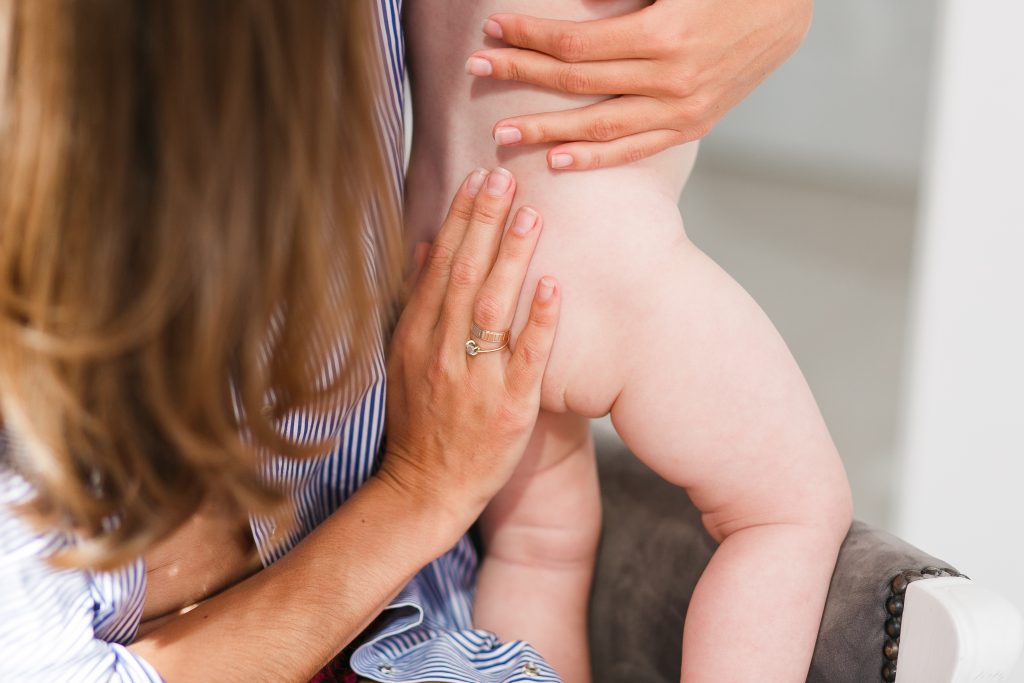
There are plenty of things that can cause a nappy rash. But the most common culprit that causes your newborn’s smooth skin to be replaced with an angry red rash is when your baby wears a wet or soiled diaper for too long.
When wearing a soiled diaper, your baby’s skin is constantly damp. Add friction and prolonged exposure to ammonia from your baby’s wastes, this can cause your baby’s skin to be irritated. Other external irritants include strong detergents that remain on cloth diaper inserts from the lack of rinsing. Or sometimes your baby might just be born with sensitive skin conditions like eczema, psoriasis or thrush.
How to tell if your baby has a nappy rash

The skin around your baby’s bottom and the genital area would look red and sore. In severe cases, the rash can even spread up towards the tummy and back area on your baby’s skin. They could look bumpy or swollen and cause a lot of discomfort and pain, which explains why your baby keeps crying and is irritable. If left untreated, the rash could get even more inflamed and cause the skin to break into ulcers.
Some preventive measures
The best solution is to prevent the rash from happening at all. Here are some of the things parents can do to reduce the chances of nappy rash.
Check your newborn’s diaper every two hours or so
Checking your newborn’s diaper more frequently will ensure that the nappy area remains dry. If your baby is already showing some rash, a clean and dry diaper will give the skin a chance to heal. Alternatively, you can also allow your baby to be diaperless by placing him or her on a waterproof pad and some towels. By doing so, this allows air to circulate freely while allowing your baby’s skin to breathe.
If you find this to be too stressful, then be sure to change wet or soiled diapers right away. Disposable diapers tend to last longer than cloth diapers because they have superabsorbent hydrogels in them. But they can also cause parents to check less often. So, regardless of whether you’re using disposables or cloth diapers, remember to check more frequently.
How you clean your baby’s skin matters too
Needless to say, most parents would prefer using wet wipes because they are easy to use and convenient. All you really need to do is open, use and discard. However, it is far better to wash your baby’s bum gently with lukewarm water and cotton wool or a soft washcloth. Some disposable wipes can still be quite harsh on a baby’s sensitive skin, which could lead to skin irritation.
When bathing your baby, you only need a tiny amount of any gentle, soap-free baby wash. After that, pat gently with a soft towel until your baby is dry and apply a simple moisturiser.
Apply some nappy rash cream after each diaper change

The purpose of nappy rash cream is to act as a barrier between your baby’s skin and any wee or poo. To be able to do that, the cream’s main active ingredient is zinc oxide, which repels water away from the skin so that it can heal. Parents can easily purchase these creams from the supermarket or at the neighbourhood pharmacy. For the cream to be effective, you need to cover the diaper area generously with nappy rash cream. A nifty way to gauge if you’ve used enough cream is to check how much cream is left at the next diaper change. Of course, this doesn’t mean you slather it on thick as though you were icing a cake. Instead, you should just see some traces of cream left on your baby’s skin for you to know that it is well protected. And no, you shouldn’t be using talcum powders to relieve nappy rash.
Be sure to rinse and clean cloth diapers thoroughly
Some babies have more sensitive skin than others, so parents need to rinse cloth diaper inserts thoroughly to ensure that they do not contain any soap residue. Likewise, if you tend to soak the cloth diapers in bleach to eliminate bacteria, remember to give them a couple of good rinses and to dry them thoroughly before use.
When should parents worry?
Generally nappy rash should clear up within three days if parents diligently apply the above preventive measures. However, you may need to seek medical advice if:
- the rash doesn’t seem to improve after a week
- the rash includes blisters, crusts or pimples and appears to be spreading
- it is starting to affect your child’s sleep and well being
- your child has a fever
- the end of your son’s penis is red and swollen or has a scab on it.
Your doctor would probably prescribe a topical cream for the rash or in some cases treat your baby’s secondary infection with an antibacterial cream or antifungal cream if it is Thrush. Otherwise, you shouldn’t need to worry too much. Most rashes will start to clear in a couple of days, and it is very rare for things to escalate to the point a paediatric dermatologist is needed.

